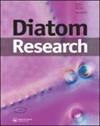Diversity and distribution of spine-bearing species of Pinnularia in eastern North America
IF 1.3
3区 生物学
Q2 MARINE & FRESHWATER BIOLOGY
引用次数: 0
Abstract
Six species of large-celled Pinnularia Ehrenberg from lakes of eastern North America, P. dariana (A.W.F. Schmidt) Mills, P. alabamae Krammer, P. bihastata (A. Mann) R.M. Patrick, P. torta (A. Mann) R.M. Patrick, P. rexlowei sp. nov. and P. spinifera sp. nov. are investigated with light and scanning electron microscopy. All six species are shown to possess marginal spines, a trait sporadically encountered in Pinnularia and generally rare in raphid diatoms. Besides having spines, the six species differ in their frustular morphology, including appearance and position of spines. We summarize data on their ecology and distribution using a set of 702 sediment core samples from 424 lakes from eastern USA and Canada. Pinnularia rexlowei is only known from Quaternary lacustrine deposits in the State of Connecticut and from the surface and subfossil sediments of two lakes in northeastern USA. The other five species are relatively common, and at least one species of spine-bearing Pinnularia was found in 34% of studied lakes. Pinnularia dariana and P. torta reach as far north as Labrador, while P. alabamae, P. bihastata and P. spinifera were only encountered south of Canada. Pinnularia alabamae and P. spinifera are characteristic for lakes with relatively soft and slightly acidic water, while P. bihastata, P. dariana and P. torta are found in a wider range of physico-chemical conditions, including alkaline and eutrophic lakes.北美东部松属带脊物种的多样性和分布
用光学和扫描电子显微镜研究了北美洲东部湖泊中的六种大细胞Pinnularia Ehrenberg,P.dariana(A.W.F.Schmidt)Mills,P.alabamae Krammer,P.bihastata(A.Mann)R.M.Patrick,P.torta(A.Man恩)R.M.帕特里克,P.rexlowei sp.nov.和P.spinifera sp.nov。所有六个物种都具有边缘刺,这一特征在细核藻中偶尔出现,在萝卜硅藻中通常很罕见。除了有刺外,这六个物种在截头体形态上也有所不同,包括刺的外观和位置。我们使用来自美国东部和加拿大424个湖泊的702个沉积物岩芯样本总结了它们的生态和分布数据。仅从康涅狄格州的第四纪湖泊沉积物以及美国东北部两个湖泊的表层和亚化石沉积物中发现了雷克洛韦细脊藻。其他五种相对常见,在34%的研究湖泊中发现了至少一种带脊椎的细脊藻属。Pinnularia dariana和P.torta最北可达拉布拉多,而P.alabamae、P.bihastata和P.spinifera仅在加拿大南部出现。阿拉巴马Pinnularia alabamae和Spiifera是水相对柔软和微酸的湖泊的特征,而bihastata、dariana和torta则存在于更广泛的物理化学条件下,包括碱性和富营养化湖泊。
本文章由计算机程序翻译,如有差异,请以英文原文为准。
求助全文
约1分钟内获得全文
求助全文
来源期刊

Diatom Research
生物-海洋与淡水生物学
CiteScore
2.70
自引率
16.70%
发文量
27
审稿时长
>12 weeks
期刊介绍:
Diatom Research is the journal of the International Society for Diatom Research. The journal is published quarterly, in March, June, September and December, and welcomes manuscripts on any aspect of diatom biology.
In addition to full-length papers, short notes and reviews of recent literature are published which need not contain all the sections required for full-length papers; we see these as being necessary to record information which is of interest but which cannot be followed up in detail. Discursive “Opinion” papers are encouraged which would not necessarily follow the normal lay-out. If extremely long papers are to be offered, the author(s) should contact the editors first to discuss any problems. Book reviews, obituaries and meeting reports can be published. All papers will be subject to critical review by the editors and referees, as appropriate to their content. Papers will be accepted in English only.
 求助内容:
求助内容: 应助结果提醒方式:
应助结果提醒方式:


